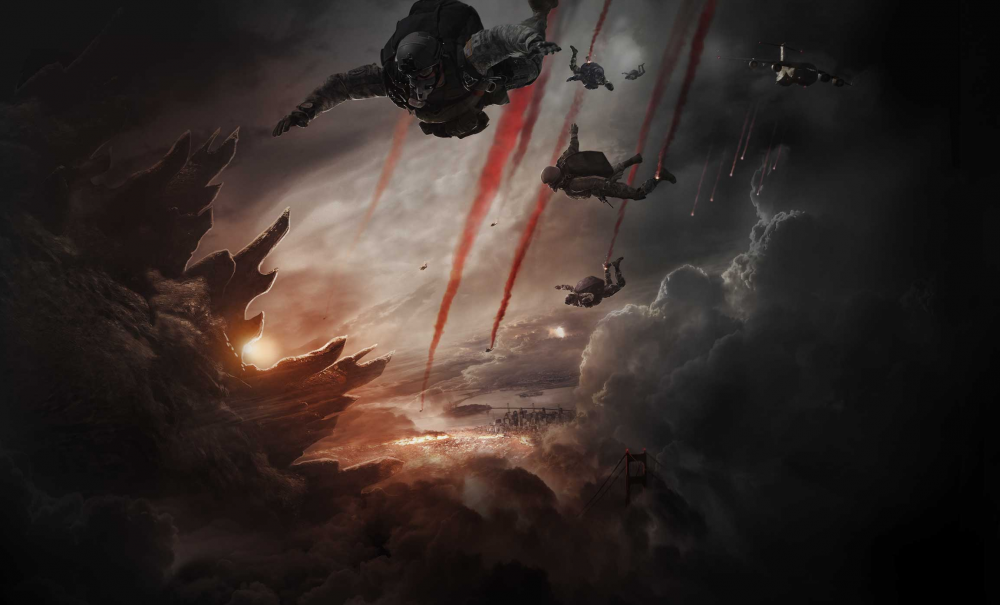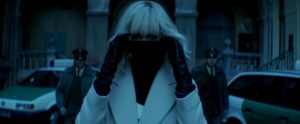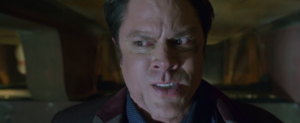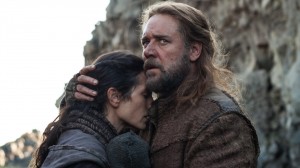
Beige. A lot of people really like looking at beige. Just think about how many people have painted their walls beige. It just blends in with everything else, y’know? But then you put other things in front of that beige wall; furniture, paintings, flat screen televisions, etc. You don’t have to be an interior decorator to know that. Now, you must be asking yourself, “What does all this have to do with Godzilla?” Well folks, Godzilla is what happens when you place every interesting object in your home behind a beige wall.
The beige wall that director Gareth Edwards is dealing with goes by the name of Aaron Taylor-Johnson. Even when he’s in films worth watching, Taylor-Johnson has never been memorable in a good way. Even his golden mustache in Anna Karenina outshines him in my memory. For some reason, without a well-crafted narrative to warrant it, he has been placed at the front and center of Godzilla. When a film features the talents of actors like Bryan Cranston, Juliette Binoche, Ken Watanabe, Sally Hawkins, and Elizabeth Olsen, there’s really no excuse to be given for either killing or shoving aside every one of these actors for the sake of making such a bland actor the star. It’s as if when prepping him for this performance, they took out the bare minimum skill he had to command the screen (because it’s something he arguably had back in Kick-Ass even though his co-stars outshone him then as well) along with any semblance of a neck due to muscle-growth. Imagine if Channing Tatum lacked the charisma and comic timing that makes him such an appealing lead actor; that’s Taylor-Johnson in a nutshell.
I don’t fault Taylor-Johnson entirely for bringing down what should have been a riveting feature though. A lot of the blame goes to the two men – Max Borenstein and Dave Callaham – who concocted a script riddled with plot holes, which I can normally excuse as long as there’s substance to the rest of the writing. There isn’t. What there is is a surprising lack of regard for its characters both human and not, and a total absence of the substance and social commentary that made the original film from sixty years ago so damn interesting. It’s actually rather embarrassing to see how the writers grasp at straws when trying to establish some connection to the metaphor that Godzilla was in his big debut. Its most glaring lack of subtlety comes when Ken Watanabe, with a distressed look on his face (which is basically the only “acting” he’s allowed to do the entire film) whips out his father’s pocket watch, only to have an American navy member whisper the word, “Hiroshima.”
The scene raises a lot of questions about Watanabe’s character, whose name I cannot remember to save my life because, frankly, I can’t remember anyone’s name other than the Cranston family surname Brody (due to it being the most obvious Jaws reference of all time). For one, it call into question whether or not Watanabe’s father lived through or passed away during the events that unfolded (the latter of which would imply that his character was in his seventies and leave me wishing I look as handsome as he does around that age). Additionally, by commenting on the historical event that is exactly why Godzilla exists, it opens a discussion that it never follows up. The presence of nuclear warfare is constant, serving as a major plot device for the film, but its danger is rarely addressed. Aside from watching the people of San Francisco scramble into shelters or out of the city, you’d never know they could be subject to the events of Hiroshima (if not far worse, as updated technology was passingly mentioned by one military man). Regardless, such a lazy attempt to vaguely bring up a discussion about nuclear warfare isn’t as insulting as having Watanabe’s assistant Sally Hawkins deliver more lines than he ever does. Then again, it’s likely that no one will remember anything either one of them says with the exception of Watanabe’s dramatic deliver of the name Gojira. It’s the hammiest bit of Godzilla, and it almost makes me wish the film had aimed for camp rather than grit.
All this complaining makes it sound like there was nothing to enjoy in Edwards’ addition to an incredibly long series (that arguably only really has one great film to its name if we’re not including Marv Newland’s brilliant Bambi Meets Godzilla). As a matter of fact, there are a surprising amount of entertaining and impressive sequences slipped into this messily edited monster of a film. If you ignore the way they move like ninjas in the night, and the amount of times they’re poorly teased at and cut away from under the guise of “subtlety,” the monster fights are top notch and damn entertaining to watch. Those issues can make one who isn’t invested in the slim story weary, but when an action scene delivers, it’s a perfect reminder for why anyone sought out the film in the first place. Long after its best actors have been disposed of, every scene that features both our titular creature and his new kaiju nemesis (the similar-to-Cloverfield looking M.U.T.O, AKA, Massive Unidentified Terrestrial Organism) is the best damn thing about it. The only exception would be DP Seamus McGarvey’s crowning glory in Godzilla: an immaculately executed ”Halo jump” sequence set to György Ligeti’s ever-haunting “Jupiter and Beyond” from 2001: A Space Odyssey.
But for all the fabulous special effects work (which isn’t showcased nearly as much as it should have been), these fights are an incredibly minor portion of the film. In fact, more often than not, Edwards chooses to cut away from the action and simply move along, sometimes not even bothering to actually end the scene. Many seem to excuse this as a throwback to the good-old days of filmmaking, but what everyone seems to forget is that in those days, each of those bits of action had a dramatic structure. It’s not about expecting a full-on action-packed assault on the senses (although I refuse to acknowledge that heavy doses of fighting are a bad thing), it’s simply about expecting a rise in action, a climax, and a denouement to the same action. Cutting to the next day after Godzilla delivers one punch to another monster isn’t tactful, it’s poor editing. They’re delay tactics, plain and simple, and not good ones at that. As disorienting as it is, the decision to do so has plenty of defenders. What are those scenes cutting away to, you ask? The human drama that makes up the bulk of Godzilla.
As mentioned though, that human drama is lackluster at best. For a film that supposedly focuses on humanity, choosing to keep its titular character as a looming presence rather than anyone of import (until the plot requires him to become one), the characters are as flat as can be and actors who deserve screen time go wasted for the sake of pushing Taylor-Johnson to the forefront. Rather than mimic the atmosphere of a Steven Spielberg film (à la J.J. Abrams’ Super 8) to mine that good old American humanism, Edwards simply picks and chooses to present moments that vaguely remind one of the director’s greatest hits. If the helicopter flying over the Philippines or the bus shaking in the rain didn’t immediately call images from Jurassic Park to mind, the monster lurking in the background being hunted by a guy with the last name Brody should be an even more blatant example. We’re treated to shades of characters we’ve already met in dozens of other films, and the writers do little to nothing to make them compelling or memorable.
Interestingly enough, the writers chose to make these monsters either completely fascinated with us or just straight up unaware of our presence entirely. Many have said the film’s human characters exist simply to present scale for how massive Godzilla really is, but if so, why is it that these monsters (with the exception of the great ol’ “savior of our city?” — question mark included) are so goddamn interested in us? The M.U.T.O. find it convenient to trace and sabotage our every move, the excuse being because we have the radiation they crave in our weaponry, but it’s really because that’s what “bad guys” do in movies. At one point the M.U.T.O are so entranced by Aaron Taylor-Johnson (were they wondering why he was in this movie too?) that they completely ignored the giant beast approaching. As for Godzilla, we watch him actively seek them out by listening to echolocation patterns, much like one of its human characters would, and then dive into a cross-world swim that’d fit the Bond theme nicely. Which begs the question: does Godzilla, in this form, exist to show how small humanity is or serve to humanize monsters far more than necessary?
If so, why isn’t there more communication between humanity and this monster? If not, why isn’t Godzilla straight up razing San Francisco or Hawaii or any of the places he visited over the course of the film down to the ground in order to remain what he is: King of the Monsters? Instead, he’s passively swimming like a dolphin next to a boat of rich white kids. Does that sound like Godzilla? Nah. But that doesn’t make those humans come off as in the way; it simply makes one realize how toned down he really is. If there’s one film in this big-ass blockbuster world that could have warranted endless wanton destruction, it’s not the superhero movies, it’s the one with not one, but three, giant monsters.
I could forgive most of what Godzilla presents if it was just another ridiculously light-hearted sequel, but it’s not. With a rather smart opening credits sequence that features video of Godzilla’s original presumed demise at the hands of nuclear weaponry, all accompanied by the only genuinely stellar Alexandre Desplat piece in the film – the rest of which falls into what you’d expect from the often-tiresome Hans Zimmer – one comes to expect a little depth and contemplation to the events unfolding. Maybe it’s my fault for expecting something with some heft to it. For expecting some subtlety before presenting the magnificent monster fights I was dreaming of. For believing that Gareth Edwards could tap into that Spielbergian humanist quality that he so claimed was his inspiration. By no means is Spielberg a director with no faults, but considering he’s created some of the great creature features (and Edwards himself has brought him up time and time again), he’s someone to take into account when discussing modern monster films, including this one.
If this is what critics are hailing as the ideal modern monster movie, then I have to say I’m disappointed. Other modern monster films like Edwards’ own Monsters and Bong Joon-ho’s The Host (and even those of the past, including Ishiro Honda’s original film) manage to impress because they understand how important the conflict between human and monster, or even simply humanity and nature, really is. They’re not simply films with human characters shoved in to anticipate the monster-action, they work despite their giant monsters. They work because even when the characters are flawed, the atmosphere isn’t. Godzilla isn’t a bad movie, and it’ll certainly be enough for many, but it’s a reminder that a monster movie shouldn’t be about the monster alone. As small as humanity is next to these grand beasts, they’re something that shouldn’t be sacrificed for the sake of fight scene.
—
Godzilla is currently available to pre-order on Blu-ray/DVD Combo.
Directed by Gareth Edwards; written by Max Borenstein and Dave Callaham; starring Aaron Taylor-Johnson, Elizabeth Olsen, Bryan Cranston, Juliette Binoche, Ken Watanabe, Sally Hawkins, David Strathairn; 123 minutes.



 Derek
Derek
 Isabelle
Isabelle